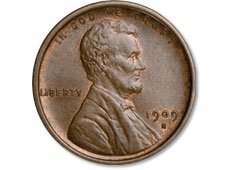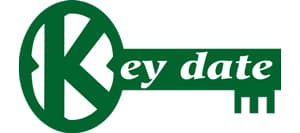Lincoln Head Cents Penny Collection
Learn About Lincoln Head Cents
It's easy to see why so many collectors seek to build Lincoln Head Cent collections. Ever since their introduction in 1909, the Lincoln cent has been among the most popular collector coins available. From controversial initials to composition and design changes, this small denomination has remained a perennial favorite.
And as we move further into the 21st century, we've seen new changes for this popular series of pennies. The Lincoln cent saw only one major design change in the last century. Then, in 2009, it bore four new reverse designs. Plus a fifth design in 2010, which continues today.
With its wide diversity of intriguing varieties, low-mintage key dates, and varied metallic compositions, the Lincoln cent series has a lot to add to any penny collection. Lincolns are accessible for young collectors and those just starting out. Yet they also offer challenges worthy of the serious numismatist.
And let's not forget that their story is a fascinating history of the United States in the 20th century. It's no wonder they are the most popular and most collected U.S. coin! Let's learn more about what you can add to your collection of pennies...

| Dates: | 1909-present |
| Composition: | varying alloys of copper, tin and zinc (see Composition) |
| Weight: | 2.50-3.11 grams (see Composition) |
| Diameter: | 19.0 mm |
| Edge: | plain |
| Mints: | Philadelphia (no mint mark), Denver (D), San Francisco (S) |

The Lincoln Cent Design
Click here to learn the uncommon history of this common coin and its historic designs.

Key Dates
Click here to discover which date and mint mark combinations are sought after by collectors, including interesting and well-known errors that most would love to add to their penny collection!

Coin Checklist
Click here for a handy checklist of Lincoln Head Cents to help you begin your penny coin collection.
Lincoln Cent Composition
From the beginning of the series in 1909 until the emergency measures for World War II began, the Lincoln head cent was struck from an alloy of 95% copper and 5% tin and zinc. This was the same alloy used for Indian Head cents from 1864-1909.
However, to free up metals needed for munitions in World War II – and avoid a coin shortage – the composition was changed.
First, partway through 1942, the tin was removed. So the cent became 5% zinc and 95% copper. Later, to free up much-needed copper, the government changed the 1943 Lincoln cent to zinc-plated steel. But these cents proved prone to corrosion, so the composition was changed again the following year.
The cents of 1944, 1945, and some of 1946 are struck from spent cartridge casings reclaimed and salvaged from troop training areas. The casings were 70% copper and 30% zinc, so enough pure copper was added to make the alloy about the same as pre-1943 composition. By the end of 1946, the original Lincoln cent copper alloy, with both tin and zinc, was resumed, and continued until the tin was removed in 1962.
From 1962 until 1982, the cent was struck in 95% copper and 5% zinc. Then, partway through 1982, the cent was changed to a core of 99.2% zinc and .8% copper with a pure copper plating.
There had almost been a new composition in 1974. The mint had been looking for alternative metals, and struck experimental cents in aluminum. However, due to unforeseen difficulties, no aluminum cents were released into circulation. The aluminum cents were supposedly destroyed, but a handful were not accounted for. And today, one of these test pieces is in the National Collection at the Smithsonian Institution.
To honor the bicentennial of Lincoln's birth and the centennial of the Lincoln cent in 2009, special collectible versions of all four commemorative designs were struck for the year's Mint and Proof Sets. These special coins boasted the same metallic content of Brenner's original 1909 cent.
Weighing 3.11 grams apiece (slightly heavier than today's cent, which weighs 2.5 grams), each coin was 95% copper, with the remaining 5% comprised of tin and zinc. They were released in conjunction with the circulating versions, which were still issued in the standard copper-nickel composition.
Ways to Collect Lincoln Pennies
If you're just starting out, it may be fun to start rooting around in your pocket change and seeing what you can find. This is a great way to get started, but it will be difficult to find older cents and scarcer mint marks.
To build a quality penny collection, it is best to purchase coins from a trusted dealer. And for the easiest way to build your Lincoln Head cents collection, consider joining Littleton's Lincoln Cent Collectors Club. Each month you'll receive a new selection of Lincoln cents to examine in the comfort and privacy of your own home.
There's no obligation and no pressure. Take up to 15 days to examine the coins and decide which you'd like to add to your collection of pennies. Then simply send payment or pay online for those coins you'd like to keep and return the rest. It's that easy.
This is a convenient and affordable way to assemble a penny coin collection, because you get to see and handle the coins before you buy. Plus, it's a great introduction to the series for a new penny collector.
Storage and Display of Pennies
A complete Lincoln Head cents collection can include over 250 coins – a good reason to consider your options for storage and display. There are several ways to store your coins. For the first-time collector, a blank cents folder may be the easiest and most attractive option. If you're not sure about dates and mint marks, you can use our handy coin checklist.
Or you can use Lincoln Head cent folders with predetermined spots for each date and mint mark to make completing your collection even easier.
If you're looking for the best combination of convenience and protection, Littleton's custom Lincoln cent albums are always a great choice. However, if you crave freedom when it comes to what, and how many coins you want in your penny collection, a coin album with blank cent pages will allow you to tailor your collection however you like.
Storage is incredibly important – you worked hard on your collection, and it deserves to be beautifully displayed! Find out more about caring for your coins here.

